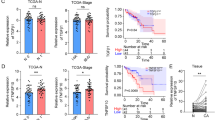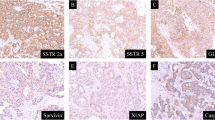Abstract
Background
Surgical impact may be associated with enhanced tumor growth and chemoresistance. This study aimed to evaluate the effect of surgical impact on the mRNA expression of survivin, epidermal growth factor receptor (EGFR), and human epidermal receptor (HER2) in tumors after pneumoperitoneum versus laparotomy.
Methods
Nude mice were inoculated intraperitoneally with human gastric cancer cells (MKN45). Then laparotomy, carbon dioxide (CO2) pneumoperitoneum, and anesthesia alone were performed randomly, after which EGFR, HER2, and survivin mRNA expression using reverse transcription-polymerase chain reaction (RT-PCR) was evaluated.
Results
The expression of EGFR and HER2 mRNA increased significantly after the experiment. However, it was higher after laparotomy than after CO2 pneumoperitoneum at almost all examined time points. Survivin mRNA expression increased significantly in the first 48 h, then returned to the control level. It was higher after laparotomy than after CO2 pneumoperitoneum 48 h after the surgical procedures.
Conclusion
The expression of EGFR, HER2, and survivin increased after each surgical procedure. However it was lower after CO2 pneumoperitoneum than after laparotomy. This might be associated with changes in the chemosensitivity of the remnant cancer cells after surgery, supporting the use of minimally invasive surgery for cancer.



Similar content being viewed by others
References
Yu W, Whang I, Suh I, Averbach A, Chang D, Sugarbaker PH (1998) Prospective randomized trial of early postoperative intraperitoneal chemotherapy as an adjuvant to resectable gastric cancer. Ann Surg 228:347–354
Han SW, Oh DY, Im SA, Park SR, Lee KW, Song HS, Lee NS, Lee KH, Choi IS, Lee MH, Kim MA, Kim WH, Bang YJ, Kim TY (2009) Phase II study and biomarker analysis of cetuximab combined with modified FOLFOX6 in advanced gastric cancer. Br J Cancer 100:298–304
Asanuma H, Torigoe T, Kamiguchi K, Hirohashi Y, Ohmura T, Hirata K, Sato M, Sato N (2005) Survivin expression is regulated by coexpression of human epidermal growth factor receptor 2 and epidermal growth factor receptor via phosphatidylinositol 3-kinase/AKT signaling pathway in breast cancer cells. Cancer Res 65:11018–11025
Jonker DJ, O’Callaghan CJ, Karapetis Cs, Zalcberg JR, Tu D, Au HJ, Berry SR, Krahn M, Price T, Simes RJ, Tebbutt NC, vanHazel G, Wiezbicki R, Langer C, Moore MJ (2007) Cetuximab for the treatment of colorectal cancer. N Engl J Med 357:2040–2048
Pinto C, Di Fabio F, Siena S, Cascinu S, Rojas Llimpe FL, Ceccarelli C, Mutri V, Gianetta L, Giaquinta S, Funaioli C, Berardi R, Longobardi C, Piana E, Martoni AA (2007) Phase II study of cetuximab in combination with FOLFIRI in patients with untreated advanced gastric or gastroesophageal junction adenocarcinoma (FULCETUX study). Ann Oncol 18:510–517
Coffey JC, Wang JH, Smith MJ, Laing A, Bouchier-Hayes D, Cotter TG, Redmond HP (2005) Phosphoinositide 3-kinase accelerates postoperative tumor growth by inhibiting apoptosis and enhancing resistance to chemotherapy-induced apoptosis. J Biol Chem 280:20968–20977
Lee SW, Gleason N, Blanco I, Asi ZK, Whelan RL (2002) Higher colon cancer tumor proliferative index and lower tumor cell death rate in mice undergoing laparotomy vs insufflation. Surg Endosc 16:36–39
Qadri SS, Wang JH, Coffey JC, Alam M, O’Donnell A, Aherne T, Redmond HP (2005) Surgically induced accelerated local and distant tumor growth is significantly attenuated by selective COX-2 inhibition. Ann Thorac Surg 79:990–995
Akiyama T, Sudo C, Ogawara H, Toyoshima K, Yamamoto T (1986) The product of the human c-erbB-2 gene: a 185-kilo Dalton glycoprotein with tyrosine kinase activity. Science 232:1644–1646
Gravalos C, Jimeno A (2008) HER2 in gastric cancer: a new prognostic factor and a novel therapeutic target. Ann Oncol 19:1523–1529
Altieri DC (2003) Validating survivin as a cancer therapeutic target. Nat Rev Cancer 3:46–54
Longlley DB, Johnston PG (2005) Molecular mechanisms of drug resistance. J Pathol 205:275–292
Shin S, Sung BJ, Cho YS, Kim HJ, Ha NC, Hwang JI, Chung CW, Jung YK, Oh BH (2001) An anti-apoptotic protein human survivin is a direct inhibitor of caspase-3 and -7. Biochemistry 40:1117–1123
Wang Q, Greene MI (2005) EGFR enhances survivin expression through the phosphoinositide 3 (IP-3) kinase signaling pathway. Exp Mol Bathol 79:100–107
Qiu L, Wang Q, Di W, Jiang Q, Schefeller E, Derby S, Wanebo H, Yan B, Wan Y (2005) Transient activation of EGFR/AKT pathway and expression of survivin contribute to reduced sensitivity of human melanoma cells to betulinic acid. Int J Oncol 27:823–830
Peng XH, Cao ZH, Xia JT, Carlson GW, Lewis MM, Wood WC, Yang L (2005) Real-time detection of gene expression in cancer cells using molecular beacon imaging: new strategies for cancer research. Cancer Res 65:1909–1917
Ikeguchi M, Liu J, Kaibara N (2002) Expression of survivin mRNA and protein in gastric cancer cell line (MKN45) during cisplatin treatment. Apoptosis 7:23–29
Nakamura M, Tsuji N, Asanuma K, Kobayashi D, Yagihashi A, Hirata K, Torigoe T, Sato N, Watanabe N (2004) Survivin as a predictor of cis-diammine dichloroplatinum sensitivity in gastric cancer patients. Cancer Sci 95:44–51
Peng XH, Karna P, Cao Z, Jiang BH, Zhou M, Yang L (2006) Cross-talk between epidermal growth factor receptor and hypoxia inducible factor-1α signal pathways increase resistance to apoptosis by upregulating survivin gene expression. J Biol Chem 281:25903–25914
Matsui Y, Inomata M, Tojigamori M, Sonoda K, Shiraishi N, Kitano S (2005) Suppression of tumor growth in human gastric cancer with HER2 overexpression by an anti HER2 antobody in a murine model. Int J Oncol 27:681–685
Suematsu T, Shiromizu A, Yamaguchi K, Shiraishi N, Adachi Y, Kitano S (1999) Convenient murine pneumoperitoneal model for the study of laparoscopic cancer surgery. Surg Laparo Endo Per 9:279–281
Narita T, Taga T, Sugita K, Nakazawa S, Ohta S (2001) The autocrine loop of epidermal growth factor receptor–epidermal growth factor/transforming factor alpha in malignant rhabdoid tumor cell lines: heterogeneity of autocrine mechanism in TTC 549. Jpn J Cancer Res 92:269–278
Revillion F, Hornez L, Peyrat JP (1997) Quuatification of c-erbB-2 gene expression in breast cancer by competitive RT-PCR. Clin Chem 43:2114–2120
Zhang T, Fields JZ, Ehrlich SM (2004) The chemopreventive agent sulindac attenuates expression of the antiapoptotic protein survivin in colorectal carcinoma cells. J Pharmacol Exp Ther 308:434–437
Anwar TA, Shiraishi N, Ninomyia S, Tajima M, Inomata M, Kitano S (2009) Activation of nuclear factor kappa B (NFκB) and induction of migration inhibitory factor (MIF) in tumors by surgical stress of laparotomy vs CO2 pneumoperitoneum: an animal experiment. Surg Endosc. doi:10.1007/s00464-009-0609-x
Abramovitch R, Marikovsky M, Meir G, Neeman M (1999) Stimulation of tumor growth by wound-derived growth factors. Br J Cancer 79:1392–1398
Rupec RA, Baeuerle PA (1995) The genomic response of tumor cells to hypoxia and reoxygenation: differential activation of transcription factors AP-1 and NFκB. Eur J Biochem 234:632–640
Lundberg O, Kristoffersson A (2005) Reduction of abdominal wall blood flow by clamping or carbon dioxide insufflation increases tumor growth in the abdominal wall: an experimental study in rats. Surg Endosc 19:720–723
Hsieh HL, Sun CC, Wu CB, Wu CY, Tung WH, Wang HH, Yang CM (2008) Sphnigosine 1-phosphate induces EGFR expression via Akt/NFκB and ERK/Ap-1 pathways in rat vascular smooth muscle cells. J Cell Biochem 103:1732–1746
Islam A, Kageyama H, Takada N, Kawamoto T, Takayasu H, Isogai E, Ohira M, Hashizume K, Kobayashi H, Kaneko Y, Nakagawara A (2000) High expression of survivin, mapped to 17q25, is significantly associated with poor prognostic factors and promotes cell survival in human neuroblastoma. Oncogene 19:617–623
Kawasaki H, Altieri DC, Lu CD, Toyoda M, Tenjo T, Tanigawa N (1998) Inhibition of apoptosis by survivin predicts shorter survival rates in colorectal cancer. Cancer Res 58:5071–5074
Mayo SC, Austin DF, Sheppard BC, Mori M, Shipley DK, Billingsley KG (2009) Evolving preoperative evaluation of patients with pancreatic cancer: does laparoscopy have a role in the current era. J Am Coll Surg 208:87–95
Tagliabue E, Agresti R, Carcangiu ML, Ghirelli C, Morelli D, Campiglio M, Martel M, Giovanazzi R, Greco M, Balsari A, Menard S (2003) Role of HER2 in wound induced breast carcinoma proliferation. Lancet 362:527–533
Jarnagin WR, Delman K, Kooby D, Mastorides S, Zager J, Brennan MF, Blumgart LH, Federoff H, Fong Y (2000) Neoadjuvant interleukin-12 immunogene therapy protects against cancer recurrence after liver resection in an animal model. Ann Surg 231:762–771
Wei JM, Shiraishi N, Goto S, Yasuda K, Inomata M, Kitano S (2008) Laparoscopy-assisted distal gastrectomy with D1 + β compared with D1α lymph node dissection. Surg Endosc 22:955–960
Acknowledgment
This work was supported in part by a Grant-in-Aid for Scientific Research (no. 050916) from the Ministry of Education, Science, Culture, and Sports, Japan.
Disclosures
Anwar Tawfik Amin, Norio Shiraishi, Shigeo Ninomiya, Masaaki Tajima, Masafumi Inomata, and Seigo Kitano have no conflict of interest or financial ties to disclose.
Author information
Authors and Affiliations
Corresponding author
Rights and permissions
About this article
Cite this article
Amin, A.T., Shiraishi, N., Ninomiya, S. et al. Increased mRNA expression of epidermal growth factor receptor, human epidermal receptor, and survivin in human gastric cancer after the surgical stress of laparotomy versus carbon dioxide pneumoperitoneum in a murine model. Surg Endosc 24, 1427–1433 (2010). https://doi.org/10.1007/s00464-009-0793-8
Received:
Accepted:
Published:
Issue Date:
DOI: https://doi.org/10.1007/s00464-009-0793-8




